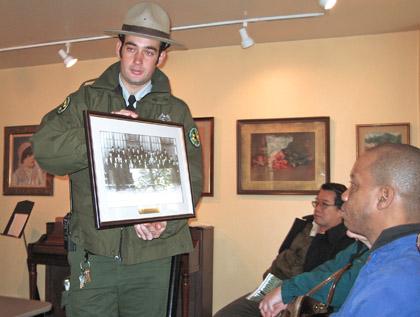By Anna Gustafson
Once home to many abolitionists and rabble rousers, including John Bowne, who successfully challenged former Gov. Peter Stuyvesant’s unpopular ban on the practice of religions other than the Dutch Reformed Church in New Amsterdam in the 17th century, Flushing is chock full of hundreds of years of history, which city residents learned about during the Flushing Freedom Mile tour Saturday.
About 30 people from throughout the city got a crash course in Flushing’s history during the tour, which visited three historical homes: Kingsland Homestead, the Lewis H. Latimer House and the Bowne House. The tour was one of five events hosted by the city Parks Department’s Urban Park Rangers as part of their second annual Queens History Weekend.
“There’s so much history in Flushing that people just have no idea about,” said Matt Symons, deputy director of the Urban Park Rangers, who grew up in Flushing and helped to found the Queens History Weekend last year.
James Bilcher, a musical therapist from Corona, said he had no idea places like the Bowne or Latimer houses held such history.
“The tour has whet my appetite,” said Bilcher, who went on the tour with his sister, Evelyn Crittenden of Corona. “I no longer am going to just pass by places like the Bowne House. I’m going to go in.”
At the Lewis H. Latimer House, the first stop on the tour, residents learned about Latimer, a son of escaped slaves who worked alongside Thomas Edison and became one of this country’s electrical pioneers.
Latimer, a Renaissance man who did everything from write poetry to paint to invent, invented the carbon filament and patented several improvements to the incandescent light bulb in 1879. He lived in the Flushing house from 1903 until his death in 1928.
“In 1903, Lewis moved to Flushing, where there was a strong, middle−class African−American presence,” said Vivian Millicent Warfield, executive director of the Latimer House. “He taught ESL to immigrants here, and he was a founding member of the Universalist Church of Flushing.”
The second stop on the tour, the Kingsland Homestead, is now home to the Queens Historical Society and was once home to Captain Joseph King, a Quaker and avid abolitionist who worked hard to eradicate slavery.
“Joseph King had a farm and was known to employ former slaves,” Urban Park Ranger Anne−Marie Vaduva told tourgoers. “He subscribed to an abolitionist newspaper and was part of the free produce movement, which advocated against people buying goods made by slaves.”
Urban Park Ranger Jeff Billak told residents at the Bowne House that John Bowne had been targeted by Stuyvesant for his Quaker beliefs.
“Bowne moved to Flushing because he heard of its flourishing Quaker community, and he started holding Quaker meetings in his house,” Billak said. “The governor went to one of the meetings and had Bowne arrested and imprisoned in 1662.”
Bowne was sent to the Netherlands for trial before the Dutch West India Co. and he exonerated himself by “appealing to the guarantees of religious liberty contained in the Flushing Patent of 1645,” Billak said.

































